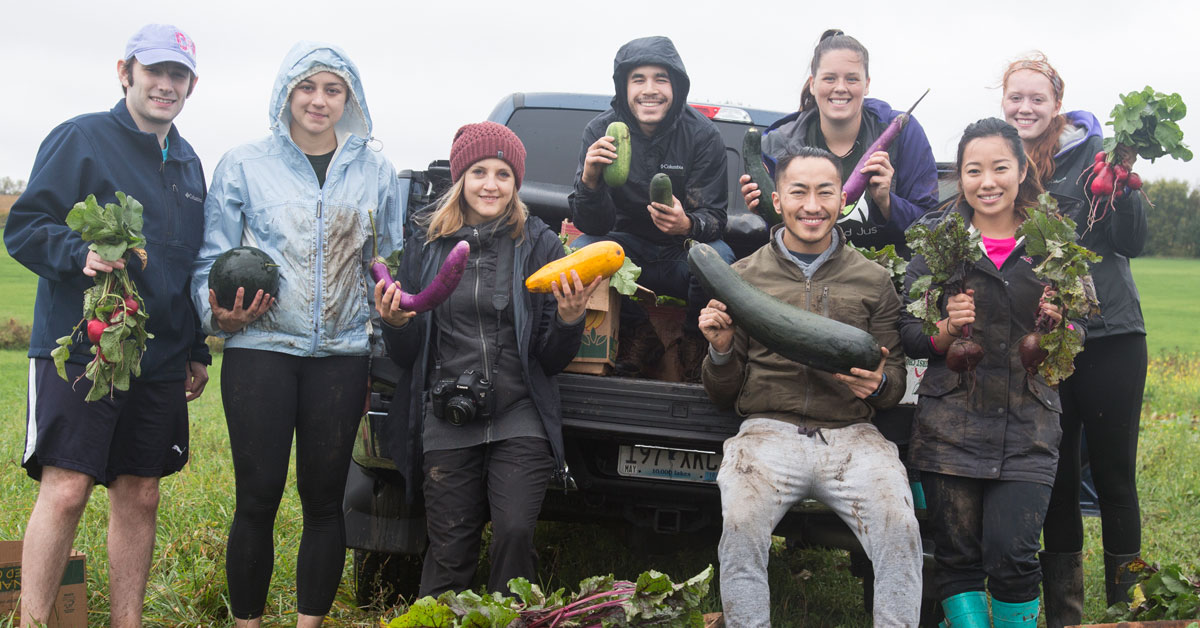In the U.S., about 14.5 percent of the population is food insecure at some point in their lives, meaning that they don’t have reliable access to enough food to keep them healthy. At the same time, 30 percent of the food in America goes to waste every year. That situation felt very wrong for a group of School of Public Health students.
In 2015, Samantha Friedrichsen, Kelzee Tibbetts, Eva Weingartl, Hannah Volkman, and Mike Kosiak were all MPH students and, although mostly in different programs, they became friends because they shared a common goal.
“We believed we could make a difference in public health. And that if we could, we should,” says Friedrichsen.
Finding their focus
As first-year students, Friedrichsen and Weingartl took “Issues in Environmental Health,” a required course for all MPH students. They remember feeling overwhelmed with all the public health issues in the world needing attention.
“Our professor said to just pick one. ‘That’s all you can do,’ he said,” says Friedrichsen. “‘Pick one and try to improve it.’”
A year later, the five students founded Twin Cities Food Justice (TC Food Justice), a growing volunteer organization that “rescues” produce from small grocery stores and farmers markets that would otherwise be thrown out and delivers it to organizations that work with food insecure communities. Today, Friedrichsen, Tibbetts, Weingartl, and Volkman remain involved with the organization.
They chose produce as their focus because it’s a food item that often goes to waste and is nutritionally dense, and also because food shelves traditionally stock non-perishable food items. What’s more, research shows that 93 percent of food shelf clients would like to feed their families more fruits and vegetables and 90 percent know how to prepare these food groups. Volkman notes that these statistics dispel the myth that food insecure people don’t know how to or don’t want to eat healthfully.
Filling a gap
Minnesota has sophisticated hunger relief programs, such as Second Harvest Heartland, that pick up slightly bruised fruits and vegetables by the semi-load from major grocery stores like Target and Walmart. Those programs deliver that produce to food shelves across Minnesota and western Wisconsin, many pallets full at a time.
But small hunger relief efforts, like neighborhood food shelves with few volunteers, can’t manage large deliveries of produce and are therefore left with no produce to distribute. At the same time, small grocery stores and farmers markets see their unsold produce going to waste because there is no way to get it to people who could put it to quick use.
Responding to those specific needs is where TC Food Justice comes in.
Each week, a team of volunteers makes produce pickups by car or bike (average pickup = 81 pounds) from donors and delivers to recipient organizations, including The Aliveness Project, Division of Indian Work, and the Brian Coyle Center Food Shelf. Since March 2016, when they made their first pick up at the Seward Community Co-op in Minneapolis and delivered it to St. Stephens Men’s Shelter, TC Food Justice has provided more than 86,000 lbs. of produce for hunger relief in the Twin Cities, getting it to people who can use it and taking it out of the waste stream.
Volkman says that the organization more and more strives to meet people where they are, seeking out populations that encounter multiple obstacles to fresh produce.
“We recognize that there are people who can’t access the hunger relief system,” she says. “The barriers are endless and include lack of mobility, work hours, transportation, undocumented status…. So we look to groups that know communities well to find ways to make it easier for people to get food.”
Through a new initiative, TC Food Justice is working with Ramsey County Assertive Community Treatment (ACT) Team, which serves adults living with severe and persistent mental illness, to deliver food directly to weekly support groups. And at a public housing high-rise in Minneapolis, a team of resident volunteers are organizing a once-a-week pop-up food shelf and TC Food Justice volunteers will work shoulder to shoulder with them to distribute fresh produce.
The model
TC Food Justice has a solid foundation built on the public health values of equity and collaboration. It works in close partnership with small grocery stores, food co-ops, and farmers markets to deliver produce to small established food shelves or temporary hunger relief efforts. TC Food Justice rescues 363 pounds of produce for every $50 in operating costs, which are low because it’s an all-volunteer organization and the produce goes directly to a distribution point, with no need for refrigeration or storage. When starting their organization, the MPH students looked to Boulder Food Rescue and the national Food Rescue Alliance for advice and practical guidance.
The impact
Increasing availability of fresh produce increases consumption, moving people closer to the recommended five servings a day. Every year since 2016, TC Food Justice has increased the amount of produce it delivers to those who have limited access to grocery stores or traditional hunger relief sites:
2018: 475 food rescues, 39,591 lbs of produce donated
2017: 296 food rescues, 25,055 lbs of produce donated
2016: 147 food rescues, 11,970 lbs of produce donated

